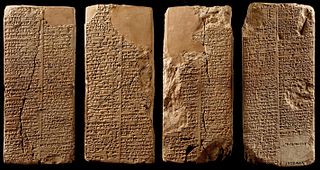| Ibate | |
|---|---|
| King of Sumer | |
| Reign | fl. late 3rd millennium BCE |
| Predecessor | Yarlagab |
| Successor | Yarla |
| House | Gutian Dynasty of Sumer |
Ibate ( fl. late 3rd millennium BCE) was the 8th Gutian ruler of the Gutian Dynasty of Sumer [1] mentioned on the Sumerian King List (SKL).
According to the SKL, Ibate was the successor of Yarlagab (Iarlagab).[ citation needed ] The latter reigned for 15 years while Ibate ruled for three (2154-2151 BC [2] ). His successor Yarla (Yarlangab) also reigned for three years.

The Sumerian King List or Chronicle of the One Monarchy is an ancient literary composition written in Sumerian that was likely created and redacted to legitimize the claims to power of various city-states and kingdoms in southern Mesopotamia during the late third and early second millennium BC. It does so by repetitively listing Sumerian cities, the kings that ruled there, and the lengths of their reigns. Especially in the early part of the list, these reigns often span thousands of years. In the oldest known version, dated to the Ur III period but probably based on Akkadian source material, the SKL reflected a more linear transition of power from Kish, the first city to receive kingship, to Akkad. In later versions from the Old Babylonian period, the list consisted of a large number of cities between which kingship was transferred, reflecting a more cyclical view of how kingship came to a city, only to be inevitably replaced by the next. In its best-known and best-preserved version, as recorded on the Weld-Blundell Prism, the SKL begins with a number of fictional antediluvian kings, who ruled before a flood swept over the land, after which kingship went to Kish. It ends with a dynasty from Isin, which is well-known from other contemporary sources.

The history of Sumer, taken to include the prehistoric Ubaid and Uruk periods, spans the 5th to 3rd millennia BCE, ending with the downfall of the Third Dynasty of Ur around 2004 BCE, followed by a transitional period of Amorite states before the rise of Babylonia in the 18th century BCE.

The Gutian dynasty, also Kuti or Kutians was a dynasty that came to power in Mesopotamia c. 2199—2119 BC (middle), or possibly c. 2135—2055 BC (short), after displacing the Akkadian Empire. It ruled for roughly one century; however, some copies of the Sumerian King List (SKL) vary between 4 and 25 years. The end of the Gutian dynasty is marked by the accession of Ur-Nammu.

Tirigan was the 19th and last Gutian ruler in Sumer mentioned on the "Sumerian King List" (SKL). According to the SKL: Tirigan was the successor of Si'um. Tirigan ruled for 40 days before being defeated by Utu-hengal of Uruk, c. 2050 BC.
Sarlagab or Zarlagab was the second Gutian ruler of the Gutian Dynasty of Sumer mentioned on the Sumerian King List as possibly reigning for six years.
Yarlagab was the 7th Gutian ruler of the Gutian Dynasty of Sumer mentioned on the "Sumerian King List" (SKL). According to the SKL: Yarlagab was the successor of Igeshaush. Ibate then succeeded Yarlagab, likewise according to the SKL.
Yarlaganda was the 17th Gutian ruler of the Gutian Dynasty of Sumer mentioned on the "Sumerian King List" (SKL). According to the SKL: Yarlaganda was the successor of Puzur-Suen. Si'um then succeeded Yarlaganda.
Yarla or Yarlangab was the 9th Gutian ruler of the Gutian Dynasty of Sumer mentioned on the "Sumerian King List" (SKL). Yarla was the successor of Ibate. Kurum then succeeded Yarla.

Si'um, also Siium, or Sium was the 18th Gutian ruler of the Gutian Dynasty of Sumer mentioned on the "Sumerian King List" (SKL). According to the SKL: Si'um was the successor of Yarlaganda. Sium was the last king of the Gutians before Tirigan.
Hablum was the 15th Gutian ruler of the Gutian Dynasty of Sumer mentioned on the "Sumerian King List" (SKL). According to the SKL: Hablum was the successor of Ibranum. Puzur-Suen then succeeded Hablum
Ibranum was the 14th Gutian ruler of the Gutian Dynasty of Sumer mentioned on the "Sumerian King List" (SKL). According to the SKL: Ibranum was the successor of Irarum. Hablum then succeeded Ibranum
Irarum was the 13th Gutian ruler of the Gutian Dynasty of Sumer mentioned on the "Sumerian King List" (SKL). According to the SKL: Irarum was the successor of La-erabum. Ibranum then succeeded Irarum

La-erabum or Lasirab was the 12th Gutian ruler of the Gutian Dynasty of Sumer.
Apilkin was the 11th Gutian ruler of the Gutian Dynasty of Sumer mentioned on the Sumerian King List (SKL). According to the SKL, Apilkin was the successor of Kurum and was succeeded by La-erabum.
Kurum was the 10th Gutian ruler of the Gutian Dynasty of Sumer mentioned on the "Sumerian King List" (SKL). According to the SKL: Kurum was the successor of Yarla. Apilkin then succeeded Kurum, likewise according to the SKL.
Inimabakesh was the fifth Gutian ruler of the Gutian Dynasty of Sumer mentioned on the Sumerian King List. Inimabakesh was the successor of Elulmesh. Igeshaush then succeeded Inimabakesh.
Igeshaush was the 6th Gutian ruler of the Gutian Dynasty of Sumer mentioned on the "Sumerian King List" (SKL). Igeshaush was the successor of Inimabakesh. Yarlagab then succeeded Igeshaush.
Puzur-Suen was the 16th Gutian ruler of the Gutian Dynasty of Sumer mentioned on the "Sumerian King List" (SKL). According to the SKL: Puzur-Suen was the successor of Hablum. Yarlaganda then succeeded Puzur-Suen

Ur-nigin, also Ur-nigina or Ur-nigar was a Governor (ensi) of Uruk who lived in 22nd century BCE.

Ur-gigir was the son of Ur-nigin and a Governor (ensi) of Uruk who lived in 22nd century BCE.